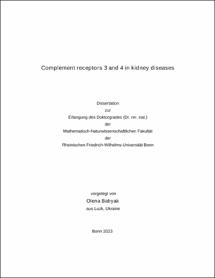Complement receptors 3 and 4 in kidney diseases

Complement receptors 3 and 4 in kidney diseases

| dc.contributor.advisor | Kurts, Christian | |
| dc.contributor.author | Babyak, Olena | |
| dc.date.accessioned | 2023-12-11T09:59:23Z | |
| dc.date.available | 2023-12-11T09:59:23Z | |
| dc.date.issued | 11.12.2023 | |
| dc.identifier.uri | https://hdl.handle.net/20.500.11811/11168 | |
| dc.description.abstract | CR3 and CR4 are among the most abundant molecules on the cell surface of DCs, monocytes/macrophages, and PMNs. Both integrins recognize common ligands among which are iC3b, ICAM-1, and fibrinogen. iC3b is generated as a result of the activation of the complement cascade and can opsonize antigens. Among the diseases characterized by the activation of the complement system are glomerulonephritis and pyelonephritis. This project aimed to investigate the influence of CR3 and CR4 on the progression of these diseases using our newly generated ItgamItgax-/- mouse line.
During the project, we found that genes encoding CR3 and CR4 are upregulated in patients suffering from several types of glomerulonephritis. Also, mice lacking both CR3 and CR4 showed attenuated symptoms of the disease, as evidenced by lower ACR and concentration of NGAL in their urine compared to WT animals. Histological analysis of kidneys from ItgamItgax-/- mice showed a lower degree of crescent formation. Flow cytometric analysis revealed a decrease in the number of cDC2s and CD4+ T cells in the kidneys of ItgamItgax-/- mice compared to the WT group, which can indicate a selective decrease in inflammation. CD4+ T cells of nephritic ItgamItgax-/- mice had also a lower expression of genes engaged in IL-1-related signaling. cDC2s of ItgamItgax-/- mice captured less antigen during cGN compared to WT cells. Also, they were less efficient at inducing the proliferation of CD4+ T cells compared to WT DCs. In the case of pyelonephritis, ItgamItgax-/- animals had also attenuated symptoms of the disease as evidenced by the lower bacterial load in their kidneys compared to the WT group and decreased inflammation on day 7 p.i. ItgamItgax-/- BMDMs contained also less viable intracellular bacteria compared to WT cells, which can indicate that due to the absence of CR3 and CR4 bacteria are not efficiently phagocytose. This led us to the conclusion that UPEC can use macrophages as a niche to evade immune response in WT animals, which is not possible in the case of ItgamItgax-/- mice. This can explain the better outcome of knockout animals. The findings presented above reveal the importance of CR3 and CR4 during the progression of crescentic glomerulonephritis as well as pyelonephritis and suggest that targeting these receptors may be a therapeutic strategy in the treatment of these diseases. | en |
| dc.language.iso | eng | |
| dc.rights | In Copyright | |
| dc.rights.uri | http://rightsstatements.org/vocab/InC/1.0/ | |
| dc.subject.ddc | 570 Biowissenschaften, Biologie | |
| dc.title | Complement receptors 3 and 4 in kidney diseases | |
| dc.type | Dissertation oder Habilitation | |
| dc.publisher.name | Universitäts- und Landesbibliothek Bonn | |
| dc.publisher.location | Bonn | |
| dc.rights.accessRights | openAccess | |
| dc.identifier.urn | https://nbn-resolving.org/urn:nbn:de:hbz:5-72607 | |
| ulbbn.pubtype | Erstveröffentlichung | |
| ulbbnediss.affiliation.name | Rheinische Friedrich-Wilhelms-Universität Bonn | |
| ulbbnediss.affiliation.location | Bonn | |
| ulbbnediss.thesis.level | Dissertation | |
| ulbbnediss.dissID | 7260 | |
| ulbbnediss.date.accepted | 18.09.2023 | |
| ulbbnediss.institute | Medizinische Fakultät / Institute : Institut für Experimentelle Immunologie (IEI) | |
| ulbbnediss.fakultaet | Mathematisch-Naturwissenschaftliche Fakultät | |
| dc.contributor.coReferee | Kiermaier, Eva | |
| ulbbnediss.contributor.orcid | https://orcid.org/0000-0003-3533-2884 |
Files in this item
This item appears in the following Collection(s)
-
E-Dissertationen (4383)




